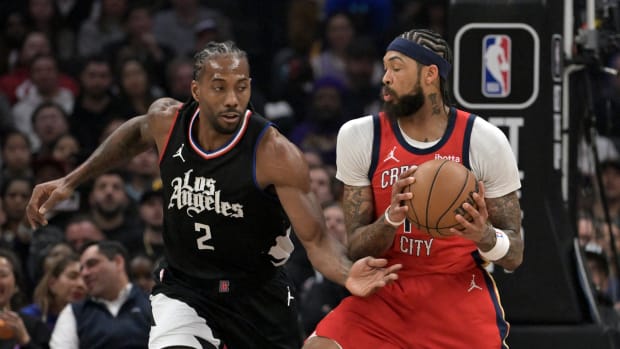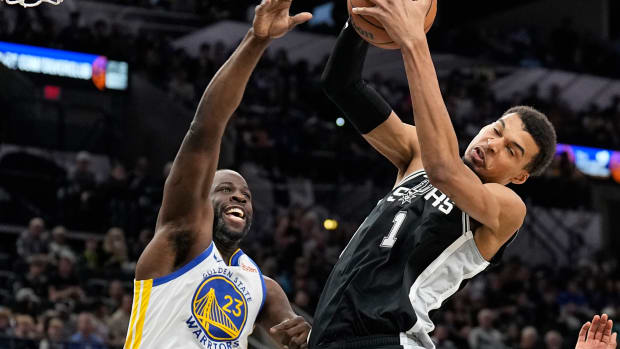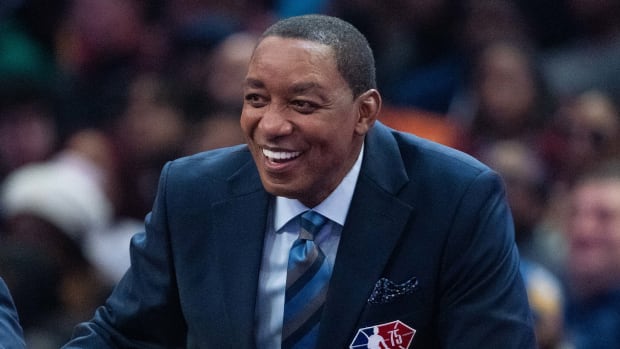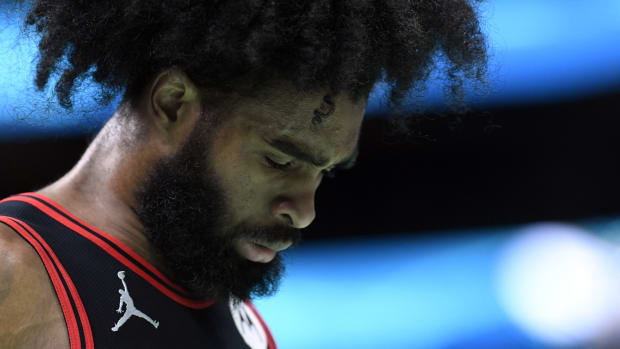Stephen Curry, Warriors Pick-and-Roll Blazers to Game 1 Death
OAKLAND, Calif. — There is no right way to defend Stephen Curry, but there are many painful ones. The Trail Blazers began the Western Conference finals with a prime example: a drop-style coverage that allowed the best shooter in the world to step into an open three-pointer whenever he liked, the basketball equivalent of self-immolation. No team wants to put itself in that position. It is Curry and the Warriors who force them there.
A playoff series against Golden State is inhospitable to most traditional centers, given the distance between the tactical battlegrounds involved and a big man’s typical comfort zone. Clint Capela shriveled into a liability as the Warriors ousted the Rockets. In their series against the defending champs, the Clippers had to nix the 7-1 Ivica Zubac from their rotation after his game was picked apart. It’s tempting to put a big, bruising rebounder on the floor to leverage the Warriors’ small-ball style against them. Doing so all but hangs that big out to dry—subjecting the slowest player on the floor to manage an endless series of defensive exchanges out on the perimeter, just as the Warriors did Enes Kanter.
Portland’s first attempt at navigating this issue was to have Kanter drop back down into the paint and below the pick-and-roll fray. Curry responded by waltzing into nine three-pointers and 36 total points, propelling Golden State to a definitive 116-94 win.
“That was very poor execution defensively on our part,” Damian Lillard said. “Just having our bigs back that far, understanding the team we are playing against—they’re not going to shot mid-range jumpers and try to attack the rim. If they see the opportunity to shoot a three, they’re gonna take it. They shoot it at a high clip. We’ve got to bring our guys up and run them off the line, and tonight they were setting solid screens and coming off shooting practice shots. That’s the last thing we need if we want to have any chance to beat this team.”
Making matters worse, it’s not just the pick-and-roll that puts Kanter in a bind. Any screen involving Kanter’s man and a shooter makes trouble for Portland, even if the shooter in question is working without the ball. Kevon Looney twice screened for Klay Thompson in the fourth quarter for a damning advantage: once from the post to free up Klay for a baseline jumper; and again on the perimeter that allowed Thompson to draw a foul on the desperate, trailing CJ McCollum. This is the bargain a team strikes in relying on a player like Kanter. His rebounding can change the course of a game. His inside scoring will keep a defense honest. But opponents at this level, Kanter has a way of giving back everything he gets.
Kanter finished the game with 10 points and 16 rebounds, but in the 27 minutes he shared the court with Curry, the Blazers were outscored by 15 points. “It was frustrating,” he admitted. How couldn’t it be? This arrangement is untenable; in a best-case scenario, Portland could only hope to dodge bullets for the better part of a game while scoring just enough to win. Even if they had pulled it off, is a plan that gives Curry the room and time to square up from outside really good process? Likely not, though the calculus involved is more complicated than it seems. Consider the alternatives. Switching is a non-starter. Having Kanter play up and "show" against Curry risks solving neither for Curry or the roll man. If the Blazers ask Kanter to trap Curry on every pick-and-roll, they expose his lack of both mobility and intuition. After the game, Blazers coach Terry Stotts was asked specifically about the possibility of trapping Curry, as Houston had. He bristled.
“I can’t remember: When [Curry] had 33 in the second half [of Game 6], were they trapping then?” Stotts shot back. “They were? And he scored 33 in the second half? OK. Yeah, we’ll look at that.”
Portland could play Kanter less or not play him at all, but it’s not as if Zach Collins or Meyers Leonard are better suited for the job. Even the injured Jusuf Nurkić wouldn’t be much better off. This very issue was the strategic centerpiece of a championship team and the greatest regular season in NBA history. If it could be easily solved, it would be.
“We’ve seen pretty much everything, and I think every defense is sort of personnel-based,” Warriors coach Steve Kerr said. “So these playoff series are always interesting, They didn’t have, you know, a lot of time to prepare, so they have got a tape to look at and I’m sure they’ll make adjustments. But you know, you’ve got to do what you’re most comfortable with, what your players are comfortable with. That’s what every team tries to do.” The Warriors simply don’t allow it. Sticking to what’s comfortable against Golden State is a recipe for disaster. But frankly, so is most everything else.
If anything, the first game of a series is the time for a team to see what it can get away with. Rotations tend to run deeper. Players feel their way through coverages. If there were a time to try something radical, it would be in a Game 1 on the road with time left to adjust. Underdogs, in particular, usually have to try improbable ideas to have any chance of closing the gap. Sometimes the only way to win is to get weird. A brazen disregard for the most dangerous scorer on the floor certainly qualifies.
All the Blazers can do now is keep searching. Matchups, lineup changes, style of coverage—everything should be on the table. No notion is too outlandish to consider where the Warriors are involved. Fortunately, McCollum already has an idea. When asked after the loss what his team could do differently to contain the pick-and-roll—he simple mechanism that broke Portland’s entire defense—he suggested a simple alternative: “Anything but what we did tonight.”


































